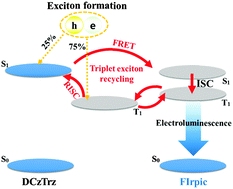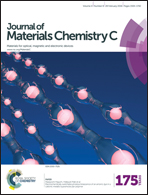Triplet exciton recycling of a phosphorescent emitter by an up-conversion process using a delayed fluorescence type low triplet energy host material†
Abstract
A low triplet energy host material with thermally activated delayed fluorescence character was applied as the host material of a blue phosphorescent emitter and was compared with a high triplet energy host material. The low triplet energy host material had triplet energy lower than the triplet energy of the triplet emitter and singlet energy higher than the triplet energy of the triplet emitter. The low triplet energy host material performed as well as a high triplet energy host material in terms of quantum efficiency by recycling triplet excitons of the phosphorescent emitter via an up-conversion process, but performed better than high triplet energy host materials in terms of driving voltage. Therefore, the thermally activated delayed fluorescence type low triplet energy host material increased the power efficiency of the devices. An energy transfer process from the low triplet energy host to the triplet emitter through the conversion of triplet excitons into singlet excitons was proposed and confirmed as the mechanism of efficient light emission.

- This article is part of the themed collection: 2016 Journal of Materials Chemistry C Hot Papers

 Please wait while we load your content...
Please wait while we load your content...